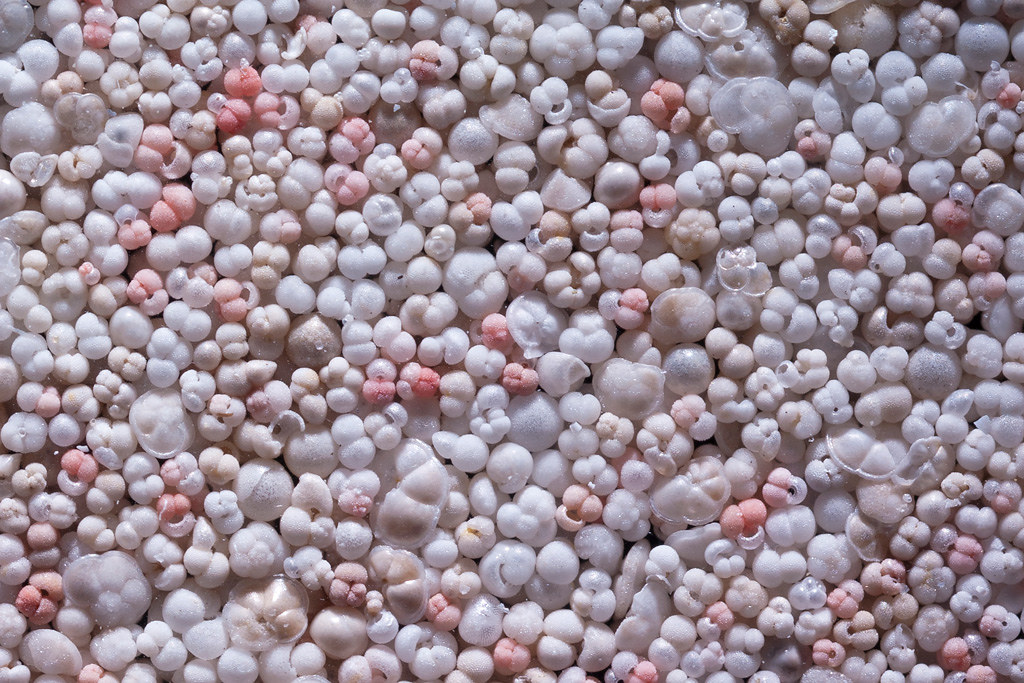一篇發表於《自然》期刊的研究發現,維繫海洋生態系的浮游動物正因氣候變遷而逐漸往南北極遷徙。
科學家比較古代沉積物岩心與現代浮游生物分布資料發現,全球浮游動物自工業化前期以來,平均移動了602公里。主要作者表示,這顯示「海洋生態系已進入人類世」。

另一位科學家警告,浮游動物的全球性移動可能對魚類到鯨類等各種海洋動物產生連鎖反應。
從水母到鬚鯨,各式各樣的海洋生物以浮游生物為食。「浮游生物」泛指所有漂浮在水中的微小生物。
該研究報告側重於「浮游動物」,而非「浮游植物」。浮游動物包括體型微小、通常是單細胞的生物,以及大型動物的卵和幼蟲,如磷蝦、水母和螃蟹。
在研究中,研究人員比較了現代浮游動物群聚分布與工業化前期的浮游動物群聚分布。
為了蒐集工業化前期的資料,研究人員從世界各地不同地點的海床深度一公分處採集沉積物樣本。該研究的觀察對象是一種稱為有孔蟲的浮游動物,牠有堅硬的外殼,可以在沉積物中保存幾個世紀。
主要作者、布來梅大學博士後研究員容克斯(Lukas Jonkers)博士解釋:「我們使用沉積物捕集器來瞭解現代物種群聚。沉積物捕集器是個大漏斗,高約2公尺,安裝在海底,能攔截從海洋表面落下的所有東西。因此能有效幫助研究人員瞭解沉積物中有些什麼。」
結果發現,現代浮游動物群聚與較近期的古代沉積物群落不同,「相異度隨溫度變化而變化」。
作者寫道:「這顯示浮游有孔蟲群聚自工業化前期以來發生了大幅變化,而且是隨著當地氣溫變化的程度變化。」
作者還發現,大多數現代浮游生物群落與遠方發現的古代樣本更相似,這表示群聚隨著時間的推移改變了位置。
透過比較工業化前期和現代浮游生物樣本,研究人員計算出該浮游動物群落從工業化前期至今平均移動了602公里。然而,位移的範圍從45公里到2557公里都有,取決於海面溫度變化的程度。
在北半球,科學家觀察到浮游生物群聚隨著暖化往北移。容克斯說:「我們沒有觀察到新物種或是新的物種組成,只看到一樣的物種隨著溫度移動。大部分情況下,這跟暖化有關,因為全球的海洋都在暖化。但少數地方是海洋變冷,這時就會看到過去生存在較低溫度環境的物種出現。」
容克斯表示,浮游生物群聚往極地移動可能是海洋暖化影響海洋生態系的前兆。
「我們認為這些現象顯示海洋生態系正在改變。如果你接受這個假設,意味著大多數物種的分布已經改變。」
然而,對於以浮游動物為食的物種來說,有些物種將隨著浮游動物進入較涼爽的水域,但有些物種可能無法適應新的環境條件。
「其他環境條件可能不同。例如,一旦往北移動,將面臨更長的夏季,光照條件可能會有所不同。所有生態網絡都得重新建立,我們不知道所有物種是否都可以適應,以及是否可以適應得夠快。」
容克斯認為,這樣的研究結果顯示,海洋已進入「人類世」。
「海洋生態系已進入人類世。我們現在觀察到的變化已經大到,你可以說這些群落與人類影響之前不同了。」

Communities of zooplankton – microscopic drifting animals that underpin marine ecosystems – are migrating poleward in response to climate change, a study finds.
By comparing ancient sediment cores to modern-day plankton distribution data, the research concludes that zooplankton communities across the globe have shifted by an average of 602km since pre-industrial times.
The findings, published in Nature, show that “marine ecosystems have entered the Anthropocene”, the lead author tells Carbon Brief.
The global shift in zooplankton populations could have knock-on impacts for the marine life that feed on them, ranging from “fish to whales”, another scientist tells Carbon Brief.
From jellyfish to baleen whales, a huge variety of marine life feeds on plankton. “Plankton” is a catch-all term referring to tiny organisms that float in water. The research paper focuses on “zooplankton” or animal plankton, as opposed to “phytoplankton” (plant plankton).
Zooplankton is made up of microscopic, often single-celled organisms, as well as the eggs and larvae of larger animals, such as krill, jellyfish and crabs.
For the study, the researchers compare the distribution of zooplankton communities in the modern day to those in the pre-industrial era.
To gather data from pre-industrial times, the researchers took sediment samples from the first centimetre of the seabed in different sites across the world.
The study focused on a group of zooplankton known as foraminifera – which have hard outer shells that can stay preserved in sediment for centuries, explains lead author Dr Lukas Jonkers, a postdoctoral researcher from the University of Bremen. He tells Carbon Brief:
“To get an idea of the modern species communities, we used sediment traps. Sediment traps are big funnels – they’re about two metres high – and they are attached to the sea floor. They intercept everything that falls from the surface ocean so, in that sense, you get a very good picture of what should be below in the sediment.”
Shifting seafood
The results show that modern-day zooplankton communities differ from those in the nearest ancient sediment site and that the “degree of dissimilarity scales with temperature change”, the authors write in their research paper:
“This suggests planktonic foraminifera communities have changed considerably since the pre-industrial period and that they have done so to the magnitude of local temperature change.”
The authors also found that most modern-day plankton communities were more similar to ancient samples found further away – suggesting that communities had shifted their location over time.
By comparing pre-industrial and modern-day plankton samples, they calculated that the average community had shifted 602km poleward from pre-industrial times to today. However, the degree of displacement ranged from 45 to 2,557km – dependent on the degree of sea surface temperature change.
In the northern hemisphere, it was found that plankton communities had shifted northwards in response to warming, Jonkers says:
“We’re not seeing new species or new species compositions, we’re just seeing that the same species have moved with temperature change. In most cases, this is caused by warming – because almost everywhere in the ocean is warming. But in some cases, the ocean is cooling – then we see a shift towards colder communities.”
The shift in plankton communities towards the poles could be a harbinger of how ocean warming is impacting marine ecosystems, Jonkers says:
“We think that these findings are indicative of what is happening in marine ecosystems. If you take that assumption, it means that most species have moved their distribution.”
However, while some species that feed on zooplankton will be able to follow it to cooler waters, others may not be able to adapt to these new conditions, he says:
“Conditions may be different. For example, if you move north, you will face a longer summer season, so the light conditions may be different. All ecological networks will need to be reestablished, and we don’t know if all the species can do so and if they can do so quick enough.”
The findings suggest that the world’s oceans have entered the “Anthropocene”, he adds:
“Marine ecosystems have entered the Anthropocene. The changes that we are seeing are now big enough that we can say that these communities are different than before human influence.”
※ 全文及圖片詳見:Carbon Brief(CC BY-NC-ND 4.0)








